
Opponents of nuclear power like to claim that Germany saved France’s power supply in 2022 because their nuclear power plants had to be shut down. Only for this purpose Germany had to start up coal-fired power plants that had already been shut down. Well, let’s do the fact check.
🇩🇪 Dieser Beitrag ist auch auf Deutsch verfügbar: »Rettete Deutschland Frankreichs Stromversorgung?«
Other opponents of nuclear power have a different thesis: They claim that it was Germany’s renewable energies that saved France’s electricity supply.
Well, let’s look at some statistics! Data source for almost all of the following figures is https://www.energy-charts.info/.
It is true that 2022 was indeed a decidedly bad year for France’s nuclear energy. Electricity production from nuclear power was well below the average of other years.
However, the assertion that in France “the” nuclear power plants in the sense of “all” were shut down is wrong: At the peak, it was half the reactors. The impression that Germany almost completely supplied France with electricity is also wrong: It was only a small part. Even though many more nuclear reactors than usual were shut down at the same time, nuclear energy (red bar in Fig. 1) accounted for the lion’s share of electricity production in France. In contrast, imports (purple bar) accounted for only a comparatively small proportion.
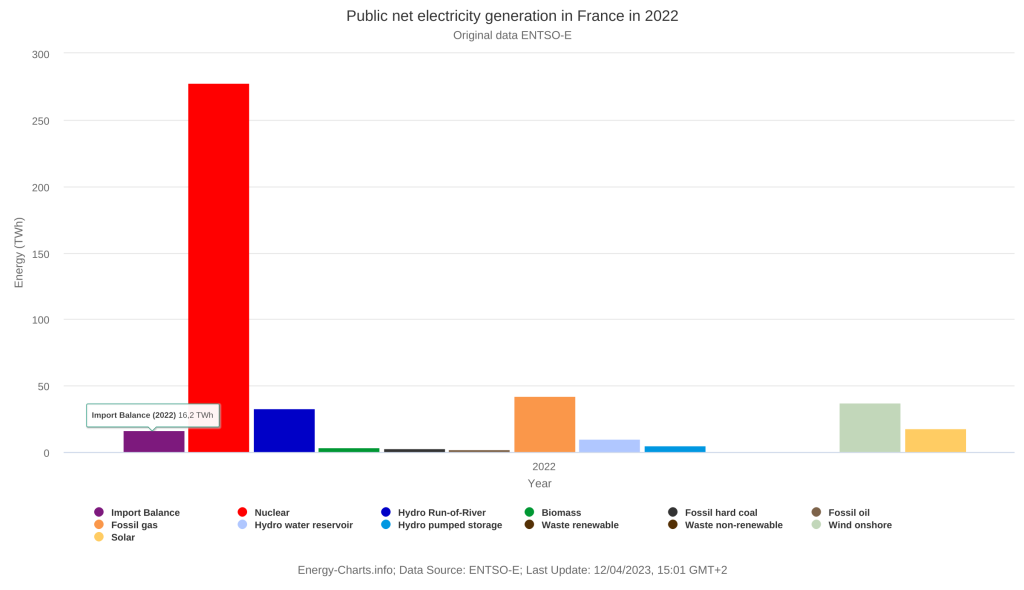
Exceptional year 2022: France was a net importer of electricity
However, it is correct that in 2022 the purple bar does not point downwards as usual, but upwards instead. France was therefore not a net electricity exporter as usual in 2022, but an importer instead, i.e., it imported more electricity than it exported.
So does the purple bar in Fig. 1 represent the electricity imports that Germany allegedly delivered to save France’s power supply? No, it isn’t. It is the balance of all of the French electricity imports and exports. Yes, that’s right, France not only imported electricity, but also exported it, on balance to Switzerland and Italy.
Did Germany save Italy’s power supply?
And the following may come as a surprise: France even exported more electricity to Italy than it imported from Germany (Fig. 2)!
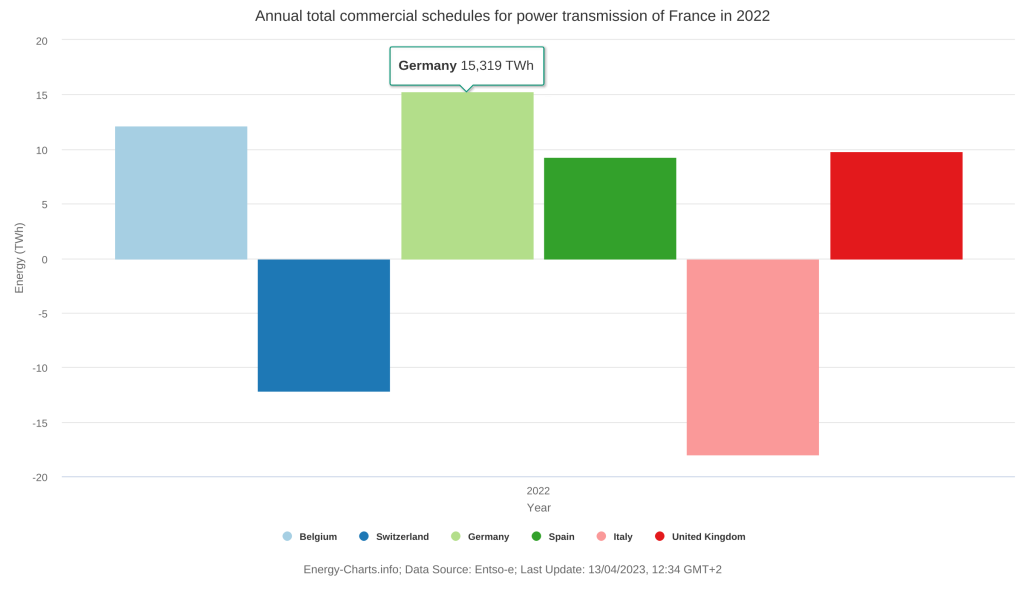
So if you absolutely want to say that someone saved someone else’s electricity supply, you could construct that Germany, with a detour via France, made sure that the lights didn’t go out in Italy. But let’s drop such nonsense!!
Speaking of Italy, since its nuclear phase-out in 1987, the country has become highly dependent on energy imports and has to bring in large quantities of electricity and gas (Fig. 3).
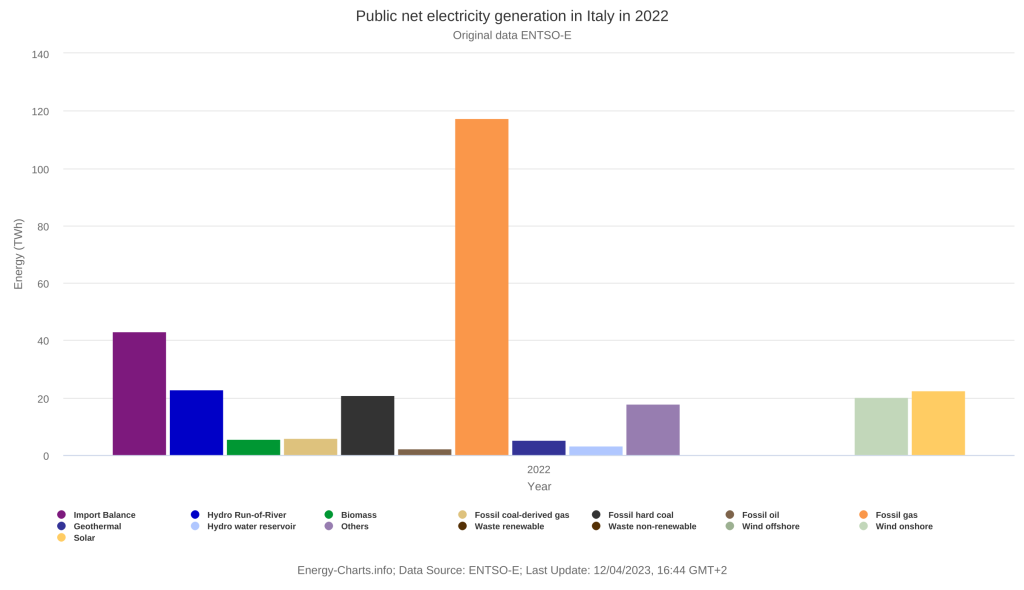
Coal and gas-fired power plants ran primarily for Germany itself
Is it now the case that Germany’s coal and gas-fired power plants were running only for France in 2022? Well, Germany’s electricity exports covered the entire electricity mix, which is why electricity from coal and gas was of course included.
A comparison of the length of the bar for exports (purple) in Fig. 4 with the bar lengths for lignite (brown), hard coal (black) and natural gas (orange) shows immediately: No, the fossil-fired power plants mainly ran for Germany itself. Only a small part of it was exported.

Has Germany saved Austria’s power supply?
Not all of Germany’s electricity exports went to France, see Fig. 5. The country exported even more electricity to Austria. Strangely, however, no one – especially no opponents of nuclear power – claims that Germany saved Austria’s electricity supply.
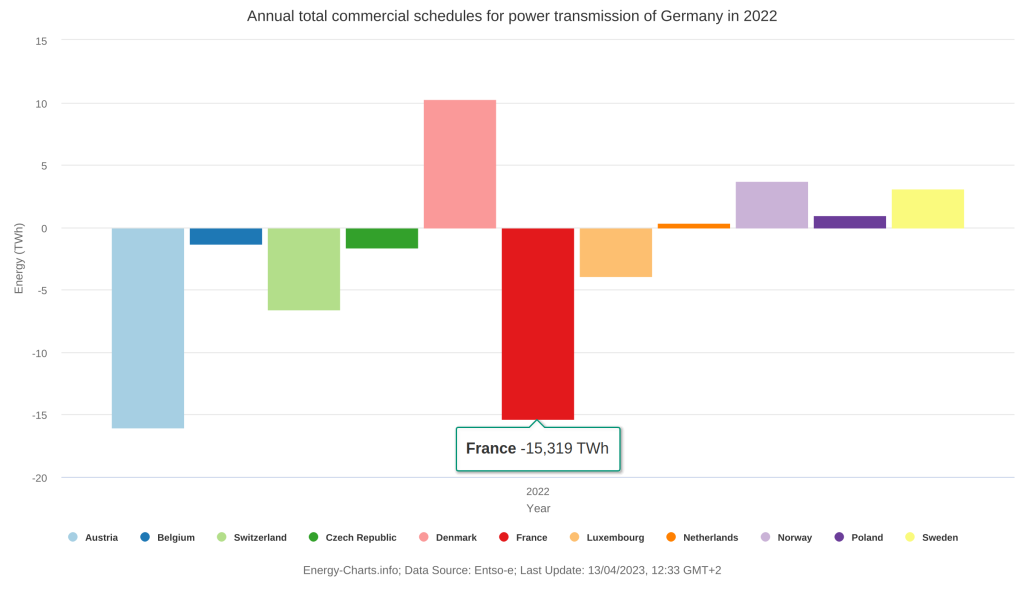
France’s nuclear power remains a crucial factor in the synchronous grid of Continental Europe
The European interconnected system is a great instrument that makes it possible to compensate for bottlenecks and overproduction in the various countries. We should not turn it into an ideological game ball.
Overall, however, we must ensure that sufficient electricity is produced at all times to cover Europe’s needs at all times. France continues to play a decisive role in this. 2022 was the exception that proves this rule.
France has just made an important change of direction in favor of nuclear energy, intends to build new nuclear reactors and prepares the existing plants for a service life of 60 years.
The causes of the weaknesses in 2021 and 2022 are being addressed, even if they will still be felt in 2023 and 2024. In the coming years, France will become even more important for Europe’s power supply.
Germany: Climate sinner and soon also net electricity importer
Germany, on the other hand, has fallen behind with its nuclear phase-out, has the highest CO₂ emissions in Europe (Fig. 6), the second highest per kilowatt hour and could become a net electricity importer as early as this year. High time to correct this fatal course!
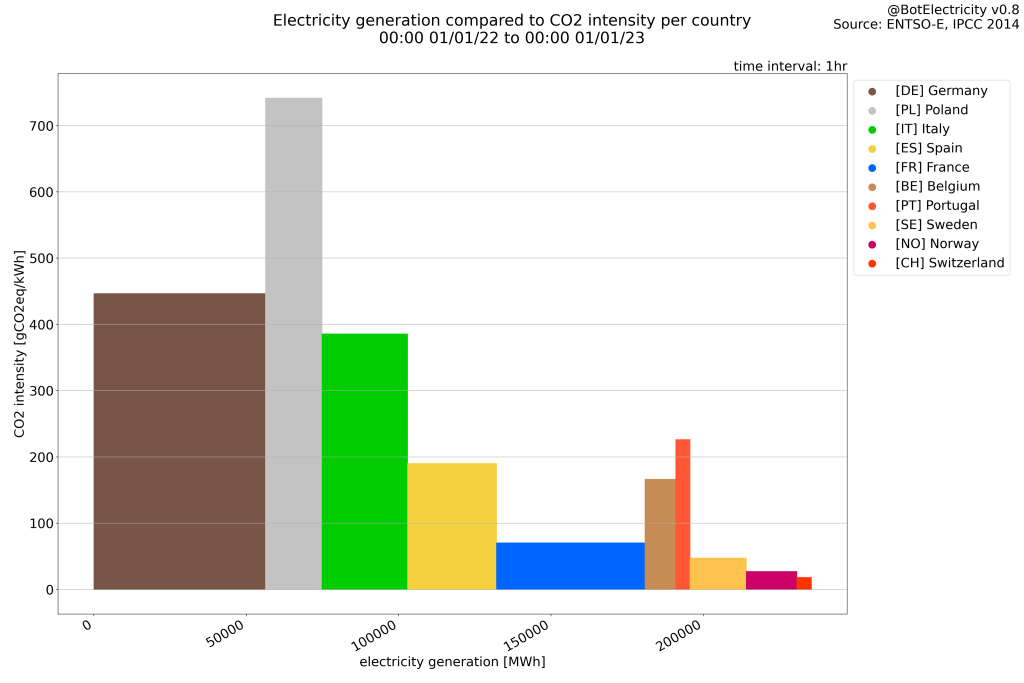
Why were so many nuclear power plants not operational in France in 2022?
But why was it that so many nuclear power plants in France were shut down in 2022? There were a number of reasons for this. Summary: First France had no luck, and then bad luck came along.
Even without the recent difficulties, the starting position of French nuclear power was anything but outstanding in comparison with other countries. According to the IAEA’s PRIS database, the energy availability of the French nuclear power plants over their entire service life was only 75.4% – well below the international average of 77.7%. In the years 2019–2021, the energy availability of French nuclear power plants dropped to just 68.2%, while the international average was 79.9% (Germany: 89.7%).
Virus swirls maintenance
The corona pandemic marked the beginning of the most recent problems. It messed up the revision plans. During the annual revision of a nuclear power plant, the reactor is shut down and some of the fuel bundles are replaced with fresh ones. In addition, repairs and maintenance work is carried out that can only be done while the system is switched off. There are special companies on site for this kind of work. For a couple of weeks, they multiply the headcount of the normal workforce, and after the work is done they move on to the next nuclear power plant. The operational schedules of these specialist companies and the overhaul times of the reactor units are well-coordinated and tightly scheduled.
However, at the beginning of the corona pandemic in 2020, EDF reduced staff at its facilities and suspended maintenance work on some reactors. That messed up the plans. Although the corona measures were gradually lifted again after just a few months, there was a backlog of revisions that continued into 2022.
10-yearly outage takes reactors offline for a long time
For many plants in France, the major decennial inspection was or is due. It includes a wealth of safety checks. The entire system is thoroughly scrutinized. As a result, a reactor can be off the grid for half a year or even longer. Perhaps cramming the 10-yearly outages of so many reactors into a relatively tight time frame was not the best idea. It would probably have been smarter to distribute them more widely over time. By the way, things were done differently in the German nuclear power plants: instead of carrying out a single, very extensive check every 10 years, the checks were spread over several normal annual outages, and this way the entire system was checked over the course of several years.
Stress corrosion cracking requires costly repairs
Then stress corrosion cracking struck: During the 10-yearly outage of the Civaux 1 reactor, cracks were found in safety-relevant pipelines. Civaux 1 is an N4, France’s newest and most powerful operating reactor type. To be on the safe side, the other three N4s were also switched off.
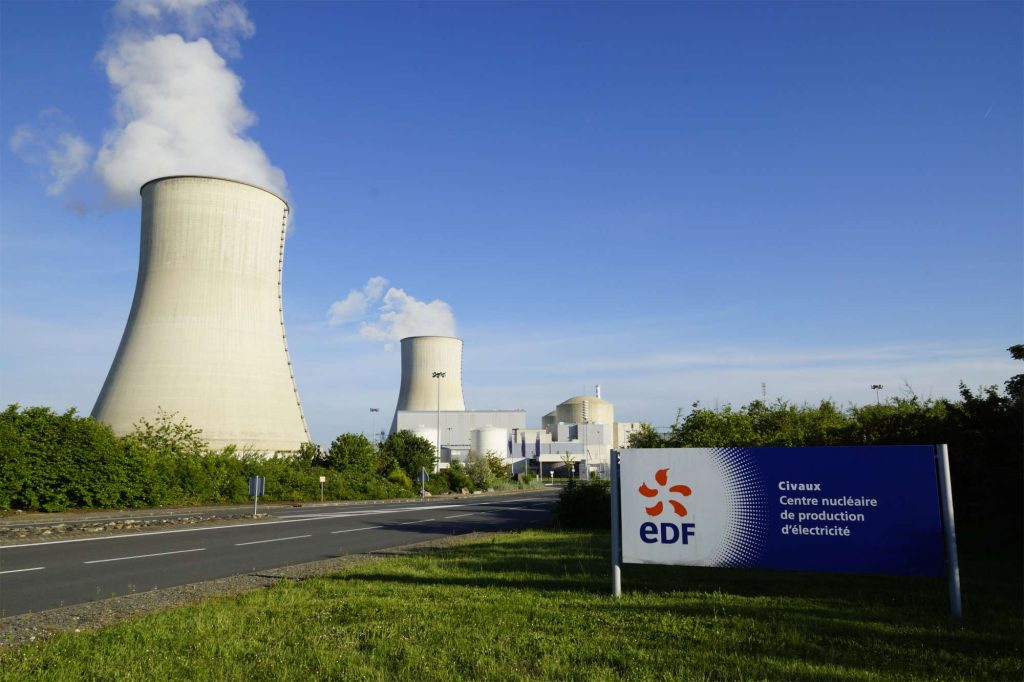
Thoroughly examining the pipeline segments in the laboratory initially took a lot of time – important in order to understand the phenomenon at all. In addition, investigations were initiated to check all other reactors for stress corrosion cracking. It turned out that the older reactors are less or not at all affected by stress corrosion cracking.
The repair is time consuming. The affected piece of pipe must be cut out and replaced with a new one. Such tubes are not in stock anywhere. They must be ordered and custom made. This is accompanied by corresponding delivery times.
In the beginning, the examination for stress corrosion cracking alone was very time-consuming. Larger cracks could be detected by ultrasound, but in order to also discover small cracks, the corresponding pipe section had to be cut out. Even if there were no findings at all, the pipeline still had to be repaired, which was time-consuming. In the meantime, the operating company EDF has developed a non-destructive and therefore time-saving ultrasonic testing method that also detects small cracks.
To German readers, I recommend the text “Sicherheitsrelevante Schäden im Sicherheits-Einspeisesystem französischer Kernkraftwerke” by the Gesellschaft für Anlagen- und Reaktorsicherheit (GRS) gGmbH. This post will be updated regularly.
By the way: Civaux 1 is in operation again since January 25, 2023.
Problems have a long-lasting effect
As already mentioned, the consequences of the problems in 2021 and 2022 will still be felt in 2023 and 2024. Strikes in France from March to early April 2023 made matters worse. Hydro and nuclear power plants were also affected. On the one hand, these strikes led to lower electricity production, but they also delayed or are delaying the inspection, repair or simply the restarting of plants whose inspection or repair has long been completed. It remains to be seen what effect these additional delays will have, certainly not in a positive way.
No shutdowns due to lack of water
By the way: Despite stories to the contrary, not a single reactor was shut down in France in 2022 due to a lack of water. Only seven plant were temporarily operated at reduced power during the heat wave, for the first time on June 11 and for the last time on August 15, 2022, namely Blayais 2 (9.5 hours), Bugey 2 (66 hours), Bugey 5 (4 hours) , Golfech 2 (36.5 hours), St Alban 1 (122 hours), Tricastin 1 (73 hours) and Tricastin 2 (66 hours). This data can be found in the list of unavailabilities published by the operator EDF.
According to the French Court of Auditors, the loss of production due to these cuts amounted to 501 gigawatt hours (GWh). Compared to annual production, this is merely 0.18%. That doesn’t really matter. Even in a historical comparison, the 2022 outages don’t ride high. In recent years, there have been 11 years with higher production losses. In some cases, they were even many times higher (Fig. 8).
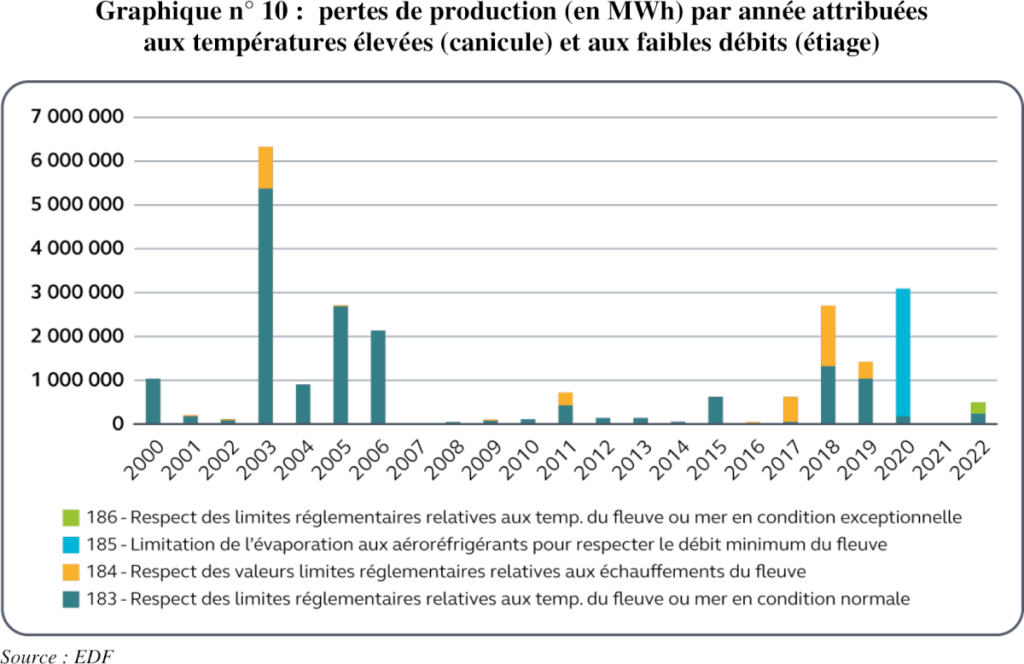
Translation of the legend:
186: Compliance with the legal limits for river or sea temperatures in exceptional conditions
185: Limitation of evaporation on the cooling towers to comply with the minimum flow rate of the river
184: Compliance with the regulatory limits related to the River heating
183: Compliance with legal limits for river or sea temperatures under normal conditions
France’s nuclear energy transition
In 2015, the French government under then President François Hollande decided to reduce the share of nuclear energy in France’s electricity generation to 50 percent. Accordingly, EDF had prepared for shutdowns and downsizing. What part this played in the difficulties in 2022 is difficult to say. Anyway, it wasn’t helpful.
France is now taking a completely different course. In March 2023, the National Assembly decided to lift the 50 percent cap. Six new EPR2 reactors are to be built, later possibly another eight. EDF will respond to this and to significantly longer service life extensions of its old plants.
Cover photo: Mellach power plant. Source: Wikimedia Commons
Rainer Klute holds a degree in computer science, a minor in physics, and is chairman and founder of Nuklearia e. V. He is convinced that Germany will return to nuclear power: “After all, we have nothing else that could supply us at any time with the energy we need in a reliable, climate and environmentally friendly way.”


Achtung: Die Daten von energy-charts (genauer: von Bruno Burger vom Fraunhofer ISE) scheinen trotz Quellangabe ENTSO-E nicht mit den Originaldaten von ENTSO-E übereinzustimmen.
Siehe Vergleich des physischen Stromflusses zwischen FR und DE Anfangs Mai:
Bild 1 (energy-charts; letztes stündliches Update 16:31):
https://i.imgur.com/WoVzQ3k.png
58 GWh
Bild 2 (die tatsächlichen Originaldaten von ENTSO-E bis zu genau diesem Zeitpunkt):
https://i.imgur.com/o393s49.png
64.8 GWh
Um zu falsifizieren oder zu verifizieren ob es sich hier um einen systematischen Fehler von energy-charts handelt kann jeder selbst die Originaldaten von ENTSO-E hier einsehen:
https://t.ly/VKlb
(geht auf ENTSO-E Webseite; Link gekürzt weil sehr lange)
Möglicherweise erscheinen die Daten auf Energy-Charts einfach nur ein paar Stunden zeitverzögert.
“zeitverzögert”
Deswegen habe ich ja explizit die Update-Zeit auf energy-charts erwähnt so dass in meinen Bildern exakt zeitgleiche Daten abgebildet werden.
Leider kann man die ENTSO-E Daten nur für jeden einzelnen Tag einsehen, aber vielleicht habe ich einmal Zeit die Daten für einen gesamten Monat aufzusummieren und dann mit den abgeschlossenen Monatsdaten von energy-charts zu vergleichen.
Bei energy-charts muss man eh schon aufpassen dass man die physikalischen Stromflüsse anzeigt und nicht die realitätsfremden “commercial schedule” Stromflüsse die für Deutschland immer ein schöneres Bild zeichnen als die physikalische Realität.
Weiters ist zu beachten dass Stromaustausch zwischen Deutschland und Frankreich auch über Belgien läuft.
Deswegen wird auf der RTE Seite
https://www.rte-france.com/en/eco2mix/cross-border-electricity-trading
Deutschland+Belgien als eine einzige Import-Export-Destination angeführt.
Insgesamt rate ich aber zu Vorsicht gegenüber energy-charts Daten (z.B. auch wenn es sich um “Energetically corrected values” handelt, ohne Erklärung dazu) da hier ein Interessenskonflikt vorliegt. Siehe Tweets von Bruno Burger.
Für einen Vergleich zwischen den Daten von ENTSO-E und Energy-Charts wäre das komplette Jahr 2022 interessant, zumindest im Zusammenhang mit meinem Artikel. Das letzte Jahr liegt auch inzwischen so weit zurück, dass irgendwelche Datenkorrekturen vollständig ausgeführt sein dürften.
Was den Stromaustausch betrifft, muss ich allerdings widersprechen. Entscheidend ist, wie viel Strom z. B. Frankreich an Deutschland verkauft und auf den Weg bringt. Wo entlang der Strom dann physikalisch fließt, ist nebensächlich. Der Strom sucht sich immer den besten Weg. Das kann der direkte von Frankreich nach Deutschland sein oder auch der Umweg über Belgien.